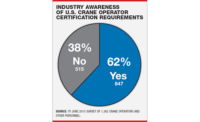Crawler cranes that use manual brakes and clutches to control the hoist are a rare breed and so are the people with the skill needed to operate them. Seeing an opportunity to help those people tout their expertise, one certifying agency has created a new designation for friction-crane operators.
"It is much more difficult to operate," says Hans Merkel, president of Kissimmee Crane School, Kissimmee, Fla., speaking of the older-style cranes. "Your foot slips off the brake, and everything comes down." The school, an authorized examiner for Crane Institute Certification (CIC), began the testing late last month.
The special designation requires candidates to pass a practical exam on a friction crane. "Many employers and some state and local jurisdictions in the U.S. and Canada require operators to be qualified on specific equipment, such as friction-operated cranes," says Debbie Dickinson, executive director of Villa Rica, Ga.-based CIC, in a statement.
Merkel can test candidates on a 60-ton-capacity 1968 American 5299 friction crane in Jacksonville, Fla., for $595; examiners also can come to a jobsite. The test involves the same set of timed tasks, such as maneuvering a live load through an obstacle course, as the test for hydraulic cranes. Candidates also must have passed a standard written exam that covers a broad range of questions about crawler cranes, from load charts and startup procedures to safety and inspection protocols.
Most crawler cranes today use electronics and hydraulics to move the load, and their structures are designed on a computer, allowing engineers to use less material. In contrast, friction-style rigs are over-engineered, with beefier steel members. "I call it the good old days," Merkel says. "You have thick steel, and you couldn't break it if you wanted to."
As a result, many vintage cranes—some approaching 50 years old—are still sought after for duty-cycle work, such as drilling shafts and driving piles. The number of friction rigs in the U.S. may be as high as 20% of the total crawler-crane population, according to one estimate.




Post a comment to this article
Report Abusive Comment